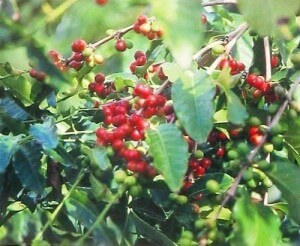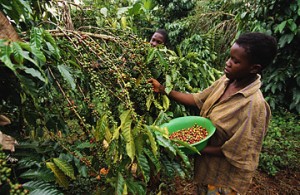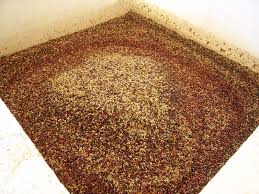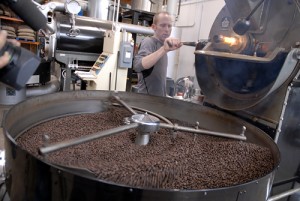Around sixty percent of the world’s population drinks coffee on a regular basis, and roughly eighty percent of adult Americans drink coffee every day. But just how do coffee beans go from a planting bed in the tropics to the coffee maker in your home or the neighborhood Starbucks? Here is the story of the journey of a coffee bean, from plant to your cup.

Growing: Coffee plants are grown in tropical climates and prefer higher altitudes with rich soil. There are many coffee growing countries around the world, although they are centered between twenty-five and thirty degrees north and south of the equator. Young coffee plants love the shade, so seeds and seedlings are planted in well shaded beds. They are kept very moist while their roots mature, and so most plantings are done in the wet season. Once they are big enough, the plants are moved to larger beds where they will grow into mature coffee plants.
Harvesting: Most coffee plants take between three and four years to mature. Once mature, they produce a fruit called a coffee cherry. These cherries can be bright red, orange or yellow. The cherries are most often hand-picked unless the farm is large enough and flat enough to employ picking machines. The cherries are either strip picked or selectively picked. In strip picking, all the cherries are taken from the plant. In selective picking, only the ripe cherries are taken and workers will cycle through the plants every ten days or so. The workers are typically paid based on the weight they can pick in a day.
De-pulping: This is one way of removing the bean from the coffee cherry. It is used in wet processing and uses a machine to remove the mucilage from the bean via centrifugal force. Beans that are de-pulped in this way are then fermented to remove any remaining mucilage.
Fermenting: This is the second stage in wet processing coffee beans. Beans are soaked for twenty-four to thirty-six hours to remove the mucilage. They are typically checked by hand and the process is done when the beans feel rough instead of slimy. After the mucilage is removed, the coffee beans are washed in clean water. Mills that use wet processing have been criticized for their environmental impact, but new low water machines are cutting down on waste. Also, some mills are now reprocessing the coffee waste water so that it is no longer a pollutant.
Drying: Drying is used on coffee beans that have been wet processed, but most commonly the drying is part of the dry processing of coffee beans. Dry processing involves leaving the entire coffee cherry out to dry in the sun, although machines are sometimes used. The coffee cherries are set in the sun and turned frequently to avoid mildew growth. They are dried to within ten to twenty percent of their original moisture content. This process can take up to four weeks. Once the coffee cherries are dried, they are hulled and the coffee bean is removed.
Sorting: The coffee beans are sorted by machine and categorized based on density and bean size. The final sorting process is based on color and is almost always done by hand. There are machines that can sort based on color, but they are not as accurate and are very expensive. The manual sorting process also provides much needed jobs for area people. Some specialty coffee beans are sorted as many as three times, with only the very best beans going on for exportation.
Roasting: Roasted beans must reach their final destination as quickly as possible, and so roasting is normally done in the importing country. Most roasters are set to 550 degrees Fahrenheit and beans are immediately cooled once they are removed from the roaster. There are several different levels of roasting and they are based on the color of the coffee beans when they are removed from the roaster. They range from light to dark roasts, with lighter roasts being very mild and darker roasts being more robust and bitter.
The roasted beans are then shipped for sale to the customer, whether it be a local coffee shop, major distributor, or the average adult coffee drinker brewing up a pot of coffee at home.
This article provided a brief overview of coffee creation process. Additional information on processing coffee can be found here and here.
Originally posted 2014-03-27 22:29:47.


